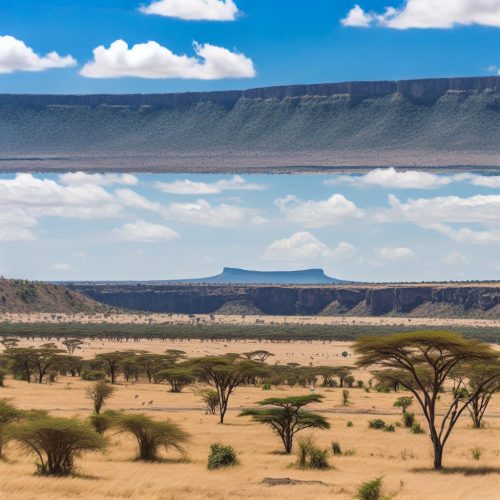Location and Overview
Hell’s Gate National Park is an intriguing destination located in Narok County, Kenya. It lies just northwest of Nairobi, making it easily accessible for travelers. Situated close to Lake Naivasha, this park is given its peculiar name due to a narrow opening in the cliffs that used to serve as a tributary to an ancient lake. This lake once provided sustenance to early human populations dwelling in the expansive Rift Valley area. Although not as large as some of the other national parks in Kenya, Hell’s Gate covers an area of approximately 68.25 square kilometers. Despite its smaller size, the park offers a unique blend of fascinating geological structures and diverse wildlife, making it a worthwhile visit for nature and adventure enthusiasts alike.
Geological Features
The landscape of Hell’s Gate National Park is characterized by its remarkable geological features. The park’s most striking attributes include towering cliffs, deep, dramatic gorges, and geothermal hot springs. The Hell’s Gate Gorge is particularly noteworthy, presenting sculpted sandstone formations that captivate the interest of many visitors.
The park’s geothermal phenomena are primarily due to its location within the Great Rift Valley, a region known for its seismic and volcanic activity. This has led to unique geological formations and active features such as hot springs and steam vents, which not only enhance the park’s natural beauty but also pique the interest of those curious about geological processes. For those wanting to explore more about these geothermal activities and related phenomena, additional resources are available at the Geology News and Information website.
Wildlife and Biodiversity
Despite its relatively limited area, Hell’s Gate National Park is a haven for a variety of wildlife. It is home to numerous herbivorous species, including zebras, giraffes, elands, and African buffaloes. Moreover, the park shelters certain predatory species like leopards and cheetahs, although their elusive nature often keeps them out of immediate sight.
In addition to mammals, the park is also an excellent spot for bird watchers. It is particularly renowned for its diversity of raptors, providing habitat to several species of birds of prey. Among these are the endangered Kenyan vulture, the augur buzzard, and Verreaux’s eagle. The presence of these bird species highlights the park’s importance as a crucial conservation area for avian life.
Outdoor Activities
Hell’s Gate National Park stands out for its unique approach to visitor interaction. Unlike many other wildlife reserves, which restrict pedestrian access to protect both visitors and animals, Hell’s Gate encourages walking and cycling. This allows visitors a more immersive experience as they traverse the park’s trails, providing a chance to get closer to nature than most other protected areas allow.
For those with a taste for adventure, the park offers several rock climbing opportunities. One of the most prominent challenges is Fischer’s Tower, a towering rock spire that beckons climbers from across the globe. Regardless of the chosen activity, visitors are urged to follow all safety guidelines and advisories provided by park officials to ensure a safe and enjoyable experience.
Conservation Efforts
Conservation is a priority at Hell’s Gate National Park. The park is part of several ongoing initiatives aimed at maintaining and restoring its ecological balance. A significant focus lies on protecting endangered species, with particular attention on vultures. These birds have seen declining numbers largely due to habitat destruction and incidental poisoning.
The Kenyan Wildlife Service oversees these conservation programs, implementing measures to safeguard the natural habitats and resident species. These efforts are crucial in ensuring that the park’s biodiversity and resources are available for the enlightenment and enjoyment of future generations.
Visitor Information
Welcoming both day-trippers and those looking for a longer stay, Hell’s Gate National Park is a favored destination among travelers. Visitors are expected to adhere to the park’s rules and regulations in order to minimize their ecological footprint.
The park is open to tourists throughout the year, although the optimal visiting period falls during the dry seasons, from July to October and January to February. During these times, the weather conditions are most favorable for outdoor exploration and wildlife observation.
Tourists who intend to visit can access more detailed information about park amenities and available accommodations by visiting the Magical Kenya website. This resource provides comprehensive insights that help ensure an informative and rewarding visit to the national park.
